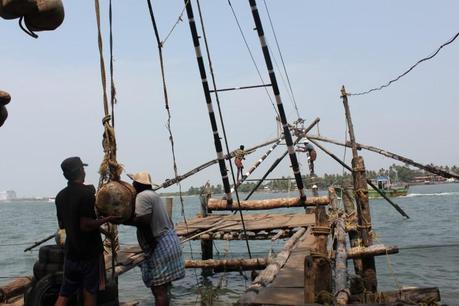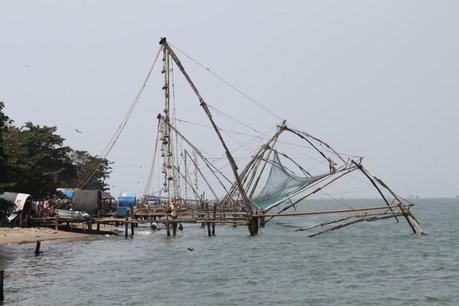 A team of fishermen operate the net. (Venus Upadhayaya/The Epoch Times)Brought by Chinese traders to the Kochi Coast of India six centuries ago, fishing nets known locally ascheena valahave fed many villages. Today, the unusual, gigantic, cantilevered machines line both sides of the inlets in Fort Kochi, and catch the fancy of tourists.Fort Kochi is an island among the group of islands in Old Kochi, a center of the world spice trade for centuries. One of the finest natural harbors in the world, it has been home to waves of various immigrants—Chinese, Arab, Portuguese—over the centuries.Alochey, the owner of a Chinese fishing net in Fort Kochi, watched while his five workers operated the net. The men worked in a kind of frenzy, pulling down ropes to which counter-weight boulders were tied. The catch: a small, lone fish.“This is peak tourist season, but water and catch is less,” explained Sabu, one of Alochey’s men, who has worked the waters for the past eight years. “We barely manage to catch 2–3 kilograms [4.5–6.6 pounds] of fish a day [in the off season]. Our livelihood these days depends on tourists, who come, attracted by the nets, and make donations.”
A team of fishermen operate the net. (Venus Upadhayaya/The Epoch Times)Brought by Chinese traders to the Kochi Coast of India six centuries ago, fishing nets known locally ascheena valahave fed many villages. Today, the unusual, gigantic, cantilevered machines line both sides of the inlets in Fort Kochi, and catch the fancy of tourists.Fort Kochi is an island among the group of islands in Old Kochi, a center of the world spice trade for centuries. One of the finest natural harbors in the world, it has been home to waves of various immigrants—Chinese, Arab, Portuguese—over the centuries.Alochey, the owner of a Chinese fishing net in Fort Kochi, watched while his five workers operated the net. The men worked in a kind of frenzy, pulling down ropes to which counter-weight boulders were tied. The catch: a small, lone fish.“This is peak tourist season, but water and catch is less,” explained Sabu, one of Alochey’s men, who has worked the waters for the past eight years. “We barely manage to catch 2–3 kilograms [4.5–6.6 pounds] of fish a day [in the off season]. Our livelihood these days depends on tourists, who come, attracted by the nets, and make donations.” Chinese Fishing nets off the Fort Kochi coast in India on Feb. 8. (Venus Upadhayaya/The Epoch Times)
Chinese Fishing nets off the Fort Kochi coast in India on Feb. 8. (Venus Upadhayaya/The Epoch Times)The best fishing season is from June through August when the southwest monsoon brings heavy rains on the western coast of Kerala state, where Kochi is located. According to Sabu, the nets earn a maximum income when used for their original purpose at this time, providing fish to the nearby fish market and hotels.During the rest of the year, particularly from November to March, the nets earn directly from the purses of tourists. Europeans escape the winter to the pleasant summer weather in Kerala.Sabu has learned some flattering phrases in English and uses them to attract tourists who look with awe upon the gigantic structure. Alochey inherited the net from his forefathers; many of the nets in Fort Kochi have been passed down over several generations. Alochey works as a carpenter, but hires others to operate his net.About 30 feet away, on another net, a 56-year-old fisherman named Benjamin called to a French couple strolling by. He and his men encouraged the woman to climb onto the large platform and watch the net being lowered into the water. The French woman helped pull the ropes while the nets rose with a catch, which she then helped put into a basket.here’s a catch the fishermen left to the end—the experience isn’t free. While the couple got ready to demount the platform, Benjamin and his crew asked for donations. Not all tourists pay up, but many do.“Whatever the tourists give, we divide it equally among us. Each of us can make 350 rupees [US$6.50] a day doing this,” explains Benjamin. The minimum wage in Kerala for most jobs is around 150 rupees a day, reaching up to about 300 rupees a day for some jobs.Sabu created another kind of experience for the tourists. He caught a live fish and put it in a water tub for the tourists to see up close.Some of the fish caught on the coast of Fort Kochi are found only in the backwaters of Kerala. Pointing at three fish swimming in a blue water tub, Sabu says, “This is tiger fish. It’s called so because of the tiger-patches on its body.”While getting a good catch requires lowering the fishing nets in the water for 5 to 20 minutes, Sabu’s and Benjamin’s teams are seen lowering them every 2 to 3 minutes. They know there are possibly no fish in the water at this time, but operating the huge nets attracts tourists.Tourism is one reason these fishing nets are still standing where they have been for many centuries.Sabu said, “Look at this fishing net to the left. It’s lying unused because it needs 7 lakhs [700,000 rupees, US$13,000] for repairs. It’s become very expensive to run these nets these days, and we have no support from government. All these fishing nets around are private property, owned for generations.”The repairs are visible in many fishing nets around—wooden bars have been replaced by steel frames in many. Benjamin said, “This is one of the changes that happened to these nets.”Source: http://www.theepochtimes.com/n2/world/chinese-fishing-nets-catching-tourists-in-india-349866.html

